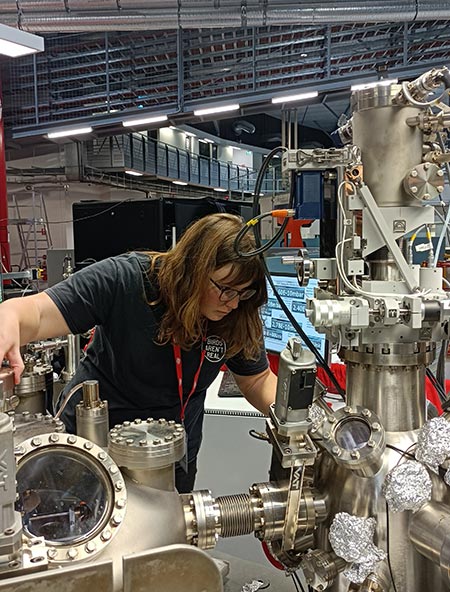Catalysts for positive change - Annual Report 2023
12 April, 2024

Caitlin Casey-Stevens using the ultra-high vacuum set-up at the Australian Synchrotron
With climate scientists warning of the need to make significant progress in reducing greenhouse gases this decade, our researchers are on the hunt to find new materials and technologies that can help tackle the problem.
A promising area of development is in catalysts, materials that can efficiently speed up chemical reactions. Catalysts are stock-in-trade for the MacDiarmid Institute, including for early career researchers and computational chemists, Dr Caitlin Casey-Stevens and Dr Charlie Ruffman.
Caitlin, an Independent Postdoctoral Research Fellow at Te Herenga Waka Victoria University of Wellington, is investigating how to make ammonia, a key ingredient in the global fertiliser industry, more efficiently so it can be used as an alternative to fossil fuels.
"The current method for producing ammonia is the Haber-Bosch process, which was invented in the 1910s," she says.
"It currently takes about 2 - 3% of the global energy use per year for this single process, because it has to be done at such high temperatures and high pressure."
But new catalysts are paving the way for ammonia to be used for certain types of transport, such as the cargo freighters and tankers that ship goods and commodities all over the world.
MacDiarmid Institute Principal Investigator Associate Professor Franck Natali has done pioneering work on the synthesis of ammonia for the marine industry, founding the deep tech start-up Liquium to commercialise the technology. Caitlin was awarded one of four MacDiarmid Institute Independent Research Fellowships in May and collaborates with Franck's team at Te Herenga Waka Victoria University of Wellington.
"The original research from Franck and a variety of collaborators around the Institute found that you could use rare earth nitrides to produce ammonia at room temperature and at low pressure," she says. "That's a real paradigm shift."
She is now employing computational chemistry techniques to study each individual step of the chemical reactions to understand how they work. This will inform future experiments undertaken by the team.
Materials to convert CO2
Dr Charlie Ruffman is also focused on catalysis, but with a different application - converting the problematic CO2 that's warming the planet into fuel and chemicals.
"It's not yet economically feasible to try and pull carbon dioxide out of the atmosphere and turn it into other things," he says.
"So we need materials that can do that quicker and cheaper. If we have those materials, then suddenly there's a business case to be made for actually capturing carbon, which would be really, really useful."
Right now these catalysts are critical to the work that needs to happen.
Dr Charlie Ruffman MacDiarmid Institute Associate Investigator
One of the best materials widely used for converting CO2 is solid copper. But Charlie is exploring a liquid metal alternative, gallium, which seems to be particularly effective at chemically reducing CO2 into useful products like ethylene. His computational techniques attempt to answer what makes gallium such a good catalyst.
Caitlin and Charlie are both Te Whare Wānanga o Otāgo University of Otago graduates and share a common pathway to the MacDiarmid Institute - they studied under Associate Professor Anna Garden in the Garden chemistry research group.
Anna introduced them to the MacDiarmid Institute and in Charlie's case, a collaboration with co-director Professor Nicola Gaston laid the foundation for a successful Rutherford Postdoctoral Fellowship application.
"That's been a two-year project for me," he says. "It wouldn't have been possible without the connections I made and the research collaborations at the MacDiarmid Institute"
Both Charlie and Caitlin have been active members of the MacDiarmid Emerging Scientists Association (MESA) and completed their PhD studies amidst the uncertainty of the pandemic.
They fondly remember the Friday night Zoom socialising calls during lockdown and the Science from the Supermarket outreach workshops which allowed students to come up with innovative experiments based on items in their shopping basket.
"We also managed to host the second largest MESA boot camp of all time in 2020, thanks in part due to the good COVID precautions" says Caitlin.
Both emerging researchers feel incredibly fortunate to have postdoctoral research positions in their chosen fields in a research sector where competition for such positions is intense.
"I think it's actually really difficult for researchers to stay in New Zealand more than a couple of years after a PhD, because there's only a certain number of things they can apply for and dip into," says Charlie, whose Rutherford Postdoctoral Fellowship will come to an end in early 2024.
Despite the uncertainty ahead, they both say the opportunities created through their MacDiarmid Institute collaborations have set them up well to pursue science that has the potential to make a real difference in lowering greenhouse gas emissions.
"We are trying to get these atomic-scale insights that can inform how we should design our materials at the macro scale," says Caitlin.
Adds Charlie: "Emissions reduction is going to be a continual challenge for the next 50 years or more. These tools and these catalysts may well be superseded in the future, but right now these catalysts are critical to the work that needs to happen."


